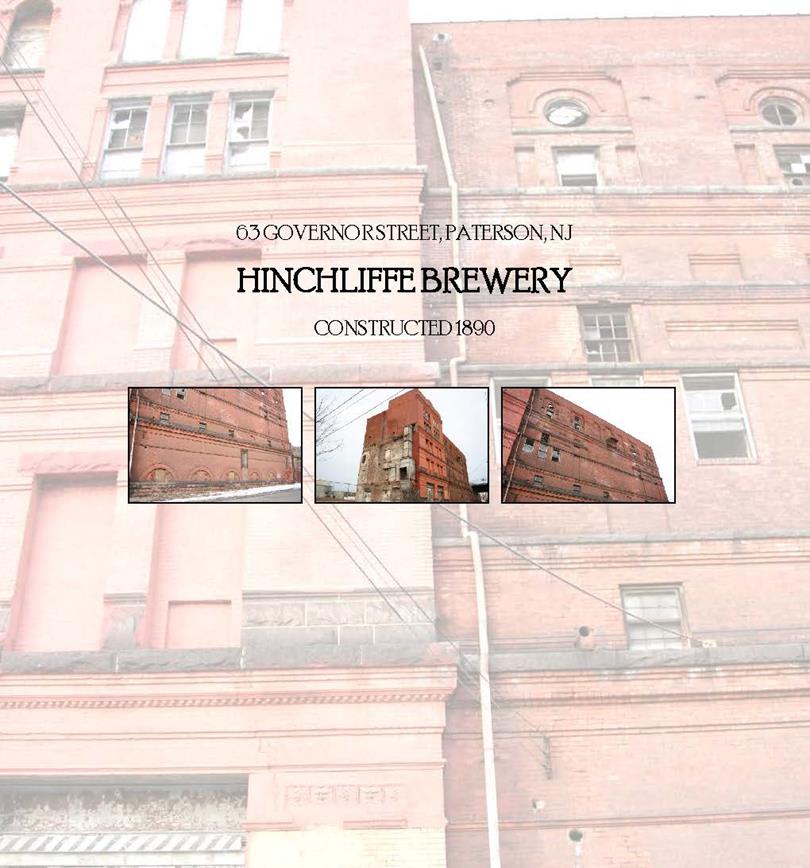
The Hinchliffe Brewery site is the last of Paterson's historic brewery industry that remains. The complex was designed as a high output modern facility of its time at the close of the nineteenth century. Its proximity to the railroad gave it the advantage of storing large quantities of grain and hops in large terra cotta hollow brick holding tanks that occupied the area adjacent to the tracks, where materials were offloaded in stored directly out of the train cars. A three story ice making facility (state of the art for 1890s) was constructed behind the main five-story brewery building and large cold storage facility.
In the twentieth century, it is not known for what purposes the complex was reused after the brewing industry was shut down during Prohibition, however it did remain intact until it was devastated by a fire in 1997. The fire caused the loss of the brew house and a good portion of the site, but spared the massive cold storage building, the silos, and so forth. Thereafter the property was used as a major dump site for the area. Due to the unsafe nature of what remained and of all the accumulated trash, there was a push by the owner to get the site cleared of the debris as well as unsafe structures. What remains on the site today is a small portion of the entire historic complex, but are architecturally significant structures, featuring a brownstone foundation, water table and belt courses. Further embellishments included terra cotta foliate blocks and brick corbelling.
 The Hinchliffe Brewing and Malting Company was formed in 1890 by the
well-known Hinchliffe brothers, the three sons of the English founder of the
Eagle Brewery in 1861. The Eagle
was likely the earliest medium-scale brewery in Paterson. John Hinchliffe
began under the name Hinchliffe & Co., and was later changed to Shaw,
Hinchliffe & Penrose in 1867 following association with those gentlemen. While
business did well, in 1878 Penrose withdrew from the firm to which then the
name changed to Shaw & Hinchliffe. Soon afterward in 1881, Shaw went abroad
due to illness and died there, leaving the firm under its founder, John
Hinchliffe, who again was alone in the endeavor until his death in 1886. His
sons John, William and James inherited the property and the business, to which
they put their minds and in 1890 set out together. They hired the well-known
firm of Charles Stoll & Son of Brooklyn to draw up plans for the city's largest
and most modern brewing facility. The brew house stood five stories tall, built
of brick and iron and trimmed with granite, and behind was a modern ice making
facility three stories tall. A four-story cold storage facility was also
constructed at the time fronting Governor Street.
The Hinchliffe Brewing and Malting Company was formed in 1890 by the
well-known Hinchliffe brothers, the three sons of the English founder of the
Eagle Brewery in 1861. The Eagle
was likely the earliest medium-scale brewery in Paterson. John Hinchliffe
began under the name Hinchliffe & Co., and was later changed to Shaw,
Hinchliffe & Penrose in 1867 following association with those gentlemen. While
business did well, in 1878 Penrose withdrew from the firm to which then the
name changed to Shaw & Hinchliffe. Soon afterward in 1881, Shaw went abroad
due to illness and died there, leaving the firm under its founder, John
Hinchliffe, who again was alone in the endeavor until his death in 1886. His
sons John, William and James inherited the property and the business, to which
they put their minds and in 1890 set out together. They hired the well-known
firm of Charles Stoll & Son of Brooklyn to draw up plans for the city's largest
and most modern brewing facility. The brew house stood five stories tall, built
of brick and iron and trimmed with granite, and behind was a modern ice making
facility three stories tall. A four-story cold storage facility was also
constructed at the time fronting Governor Street.The 1890s was the high time for the brewing industry in Paterson. The four main breweries in Paterson consolidated as the Paterson Consolidated Brewing Co. and in 1899 the Hinchliffe brothers also joined and became board leaders of the organization. John Hinchliffe died in 1915, the same year that more than 30 of Paterson's saloons were closed due to the lack business. The brewing industry in Paterson was soon thereafter crippled and dissolved by the Temperance movement and prohibition era of the 1920-30s.
References
Archimede, Gianfranco. "Paterson Historic Mills Group Municipal Historic Site Designations Staff Opinion of Eligibility," 2012.
Hyde, E. B. Atlas of Passaic County, N.J. 1877.
Robinson, E. Atlas of the City of Paterson, New Jersey, 1884.
Robinson, E. Atlas of the City of Paterson and Haledon, New Jersey, 1899.
Mueller, A. H. Atlas of the City of Paterson, New Jersey, 1915.
Sanborn Map Company Insurance, Maps of Paterson, New Jersey, 1931.
Sanborn Map Company Insurance, Maps of Paterson, New Jersey, 1915.
Sanborn Map Company Insurance, Maps of Paterson, New Jersey, 1899.
Sanborn Map Company Insurance, Maps of Paterson, New Jersey, 1887.
Trumbull, L. R. A History of Industrial Paterson, 1882.
Cultural Resources Consulting Group, "Historical Architectural Investigation, 69-83 Straight Street, Block 3113, Lot 1 and 96-112 Harrison Street, Block 3113, Lot 2," 2008.
Paterson Daily and Weekly Guardian, "City of Paterson, N.J." 1898.